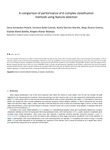A comparison of performance of K-complex classification methods using feature selection

Use este enlace para citar
http://hdl.handle.net/2183/18099
A non ser que se indique outra cousa, a licenza do ítem descríbese como Atribución-NoComercial-SinDerivadas 3.0 España
Coleccións
- GI-LIDIA - Artigos [61]
Metadatos
Mostrar o rexistro completo do ítemTítulo
A comparison of performance of K-complex classification methods using feature selectionAutor(es)
Data
2016-01-20Cita bibliográfica
Elena Hernández-Pereira, Veronica Bolón-Canedo, Noelia Sánchez-Maroño, Diego Álvarez-Estévez, Vicente Moret-Bonillo, Amparo Alonso-Betanzos, Information Sciences, Information Sciences 328 (2016), pp. 1–14
Resumo
[Abstract] The main objective of this work is to obtain a method that achieves the best accuracy results with a low false positive rate in the classification of K-complexes, a kind of transient waveform found in the Electroencephalogram. With this in mind, the capabilities of several machine learning techniques were tried. The inputs for the models were a set of features based on amplitude and duration measurements obtained from waveforms to be classified. Among all the classifiers tested, the Support Vector Machine obtained the best results with an accuracy of 88.69%. Finally, to enhance the generalization capabilities of the classifiers, while at the same time discarding the existing irrelevant features, feature selection methods were employed. After this process, the classification performance was significantly improved. The best result was obtained applying a correlation-based filter, achieving a 91.40% of accuracy using only 36% of the total input features.
Palabras chave
Feature selection Machine learning
K-complex classification
K-complex classification
Descrición
The final publication is available at ScienceDirect via http://dx.doi.org/10.1016/j.ins.2015.08.022
Versión do editor
Dereitos
Atribución-NoComercial-SinDerivadas 3.0 España
ISSN
0020-0255
1872-6291
1872-6291






